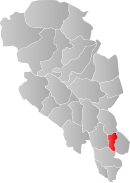Vestre Toten
| Vestre Toten kommune | |||
|---|---|---|---|
| Municipality | |||

|
|||
|
|||
 Vestre Toten within Oppland |
|||
| Coordinates: 60°39′10″N 10°35′46″E / 60.65278°N 10.59611°ECoordinates: 60°39′10″N 10°35′46″E / 60.65278°N 10.59611°E | |||
| Country | Norway | ||
| County | Oppland | ||
| District | Toten | ||
| Administrative centre | Raufoss | ||
| Government | |||
| • Mayor (2011) | Leif Waarum (Ap) | ||
| Area | |||
| • Total | 249 km2 (96 sq mi) | ||
| • Land | 231 km2 (89 sq mi) | ||
| Area rank | 303 in Norway | ||
| Population (2004) | |||
| • Total | 12,597 | ||
| • Rank | 86 in Norway | ||
| • Density | 54/km2 (140/sq mi) | ||
| • Change (10 years) | -4.0 % | ||
| Demonym(s) | Vestretotning | ||
| Time zone | CET (UTC+1) | ||
| • Summer (DST) | CEST (UTC+2) | ||
| ISO 3166 code | NO-0529 | ||
| Official language form | Bokmål | ||
| Website | www |
||
|
|
|||
Vestre Toten is a municipality in Oppland county, Norway. It is part of the traditional region of Toten. The administrative centre of the municipality is the village of Raufoss.
The name comes from the Old Norse word Þótn. The meaning of Toten is unknown (maybe "the pleasant district"). The meaning of the name Vestre Toten is "(the) western (part of) Toten". (The parish of Toten was divided in 1825.)
The coat of arms were granted on 3 May 1991. The arms show two silver knives on a green background. They are a typical type of knife from the area (the special "Toten-knives"). It symbolizes the long tradition of wood carving. The arms were designed by Inge Rotevatn.
According to the sagas, Halfdan Hvitbeinn (Whiteleg) was the first Yngling in Norway. He conquered Romerike, part of Hedmark, part of Vestfold, and Toten. He was killed in Toten around the year 740.
In 1021, according to saga, King Olaf (reigned 1015-1028) converted Toten to Christianity. Also, King Håkon IV (reigned 1217–1263) came to Toten around the year 1226 to settle local unrest.
Christian II (1481-1559) was a Danish monarch and King of Denmark, Norway (1513-1523), and Sweden (1520-1521), under the Kalmar Union. Prior to becoming king, Duke Christian was sent to Norway in 1506 by John II (also called Hans), King of Norway (1483 – 1513) to take charge of the kingdom. In 1507, he became aware of a revolt in Hedmark. In early 1508, he took a force there, routing the rebellion. He then rowed across lake Mjøsa to Toten, capturing residents, imprisoning them in the vaulted cellar of the rectory in Østre Toten and torturing them there. As a result, he determined that Bishop Karl of Hamar had been behind the rebellion. With Bishop Karl as his captive, he was able to suppress the unrest.
...
Wikipedia


